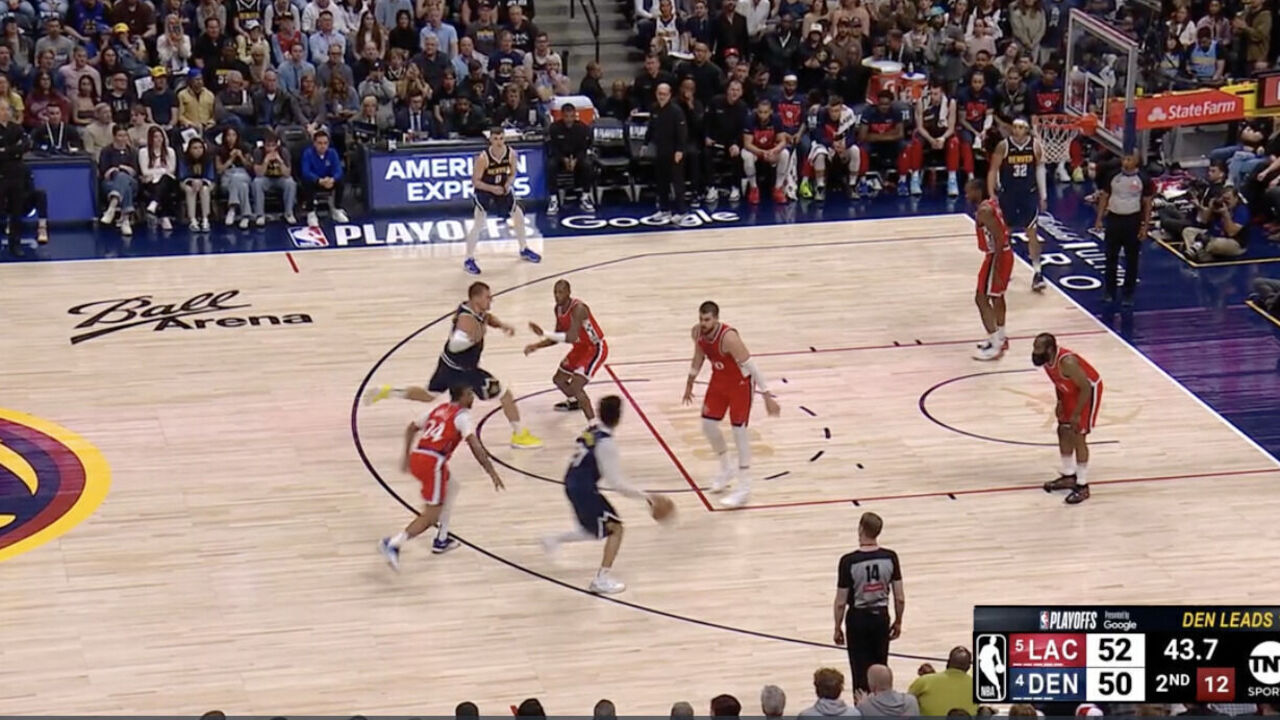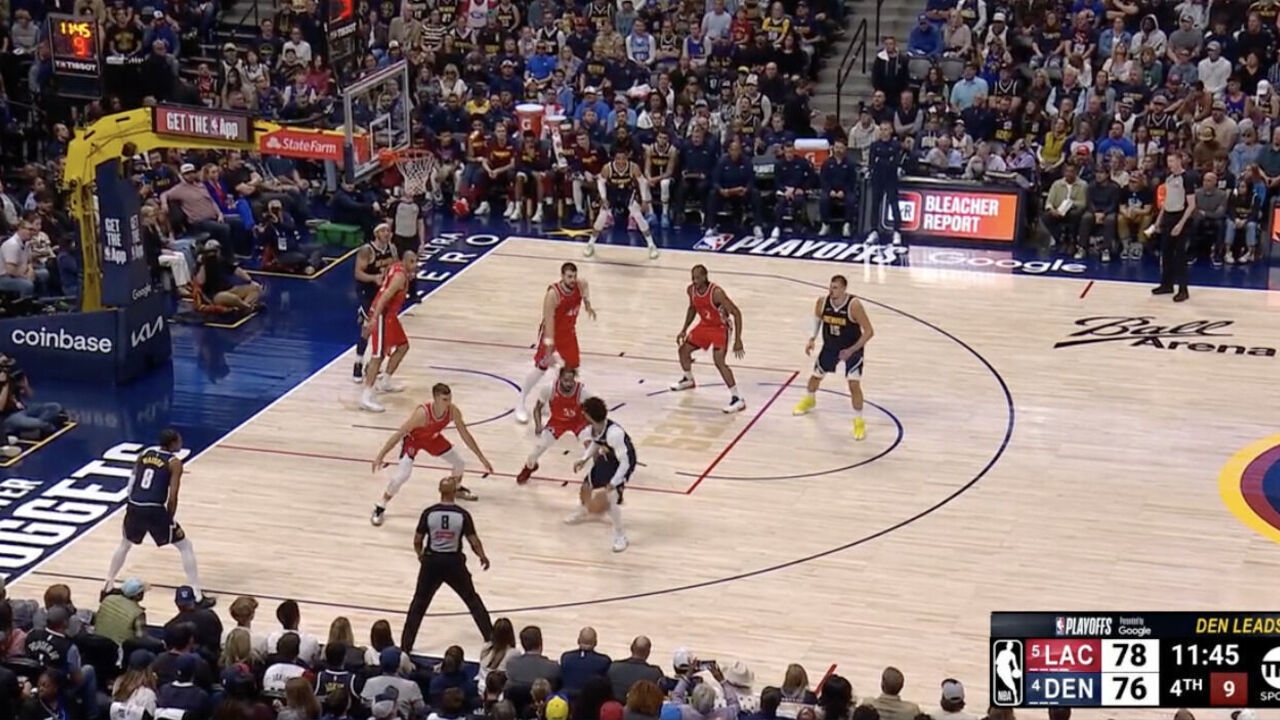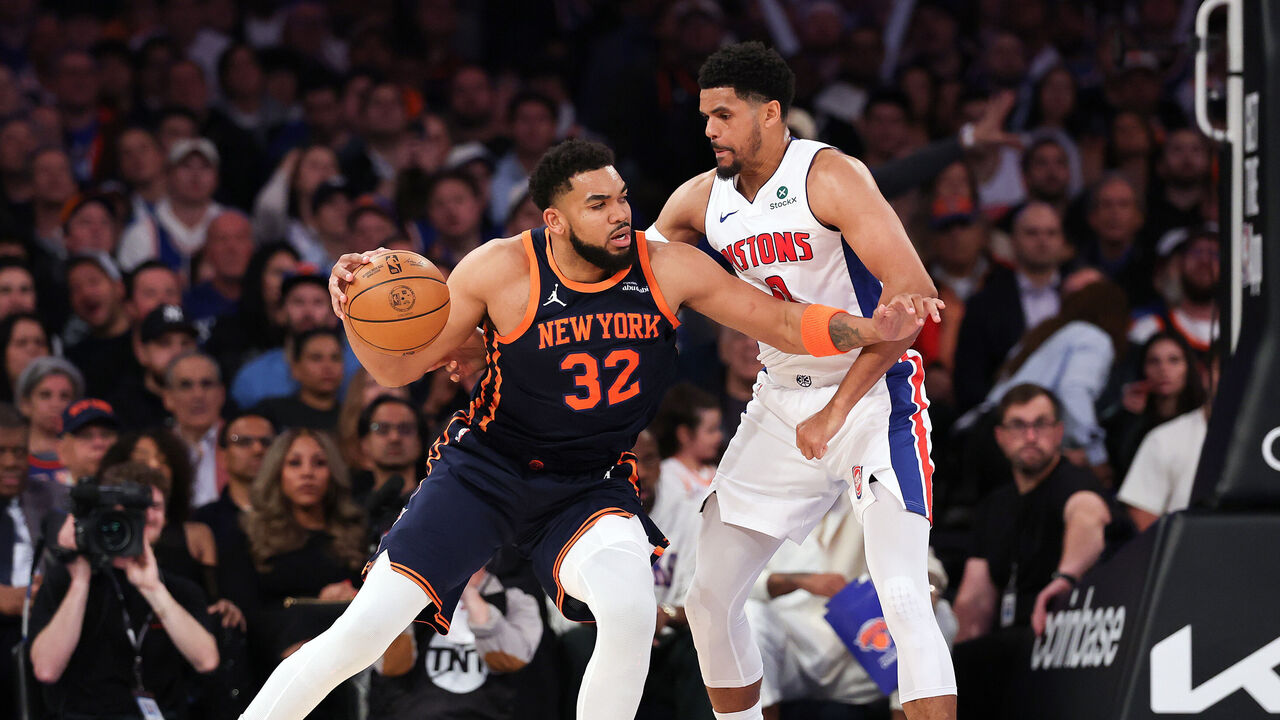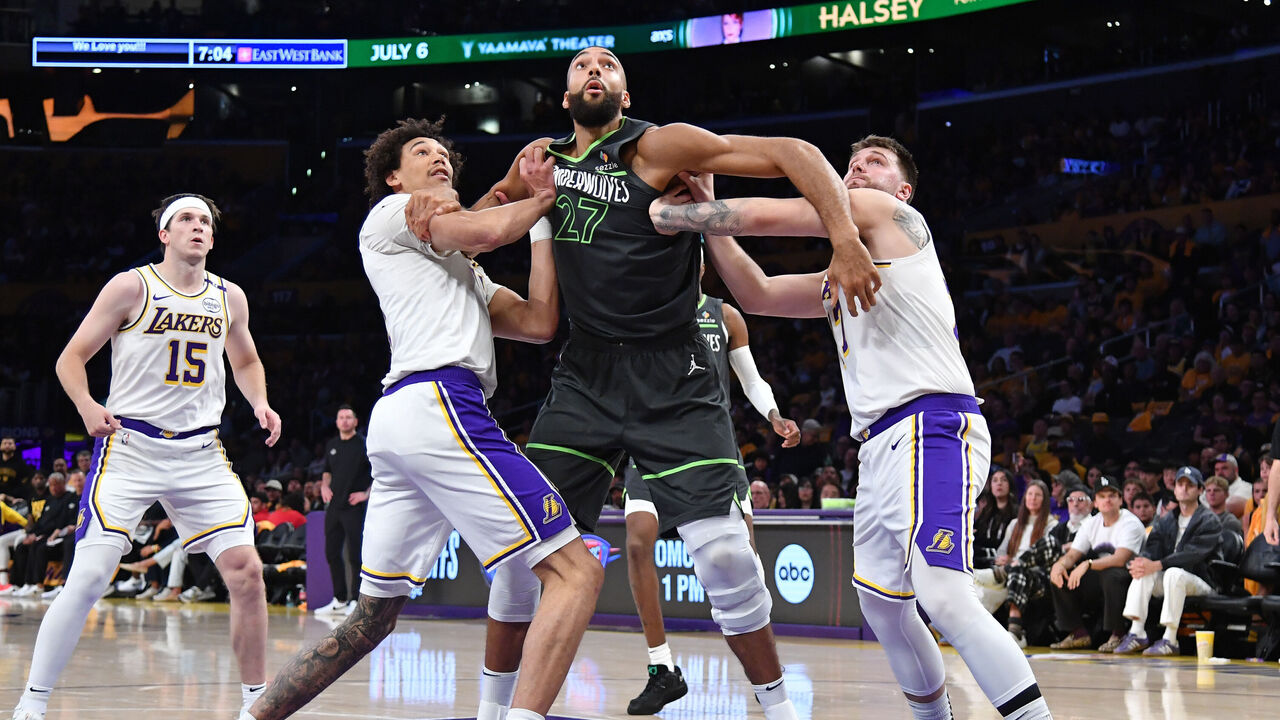4 major observations from the NBA's 1st round
The 2025 playoffs are in full swing, and it's already given us plenty to digest. With each series having completed two games, here are four observations from the first round.
Clippers-Nuggets a battle of wills, defensive tactics
The best series of the opening round has featured two contests decided by a grand total of five points, with each side taking one of them on the strength of a brilliant performance from its unique superstar. Nikola Jokic put up 29 points, nine rebounds, 12 assists, and three steals to lead Denver to a 112-110 overtime win in Game 1. Kawhi Leonard responded with a preposterous shooting display, scoring 39 points on 15-of-19 from the field (with just one of those attempts coming at the rim and five inside the paint) to carry L.A. to a series-tying 105-102 triumph in Game 2.
While those two are the series' main characters, the fun of this matchup is seeing how the other pieces on the board interact with and respond to them. For Game 2, the Clippers devised and executed a solid game plan for slowing down Jokic as a roll man in his two-man actions with Jamal Murray, which burned L.A. (as they have so many other teams over the years) in Game 1. This time out, Jokic was consistently met with early, aggressive, high tags before his short roll could take him anywhere dangerous.
Here's Kris Dunn intercepting him from the high slot:

And here's Leonard doing so after sprinting up from the corner:

You can see how crowded the paint is as the Clippers collectively shrink in off Denver's myriad non-shooters. As a result, Jokic attempted just eight 2-pointers after taking 20 in Game 1, and his elbow touches plummeted from 15 to four. He responded by popping to the 3-point line a lot more and starting more possessions with the ball in his hands. That was reflected in his average touch time, which went from 2.6 seconds in Game 1 to 3.5 seconds in Game 2 as the Clippers took away a lot of the quick-hitting stuff he and the Nuggets thrive on.
The fact that he was able to counter by shooting 4-of-8 from deep and turning into more of a pick-and-roll ball-handler and drive-and-kick attacker is the reason he's Nikola freaking Jokic. But the Clippers also did a great job defending him in those scenarios, with Ivica Zubac deserving the lion's share of the credit. Jokic passed up a lot of the pick-and-pop 3-point looks L.A. conceded and committed seven turnovers while driving into traffic. He'll be prepared with more counters in Game 3, and I'd expect Denver as a team to be more dialed in with its weak-side cuts to punish the three-on-two pick-and-roll coverage.
Meanwhile, after committing seven turnovers of his own in Game 1, Leonard decided he didn't want to bring a second defender his way unless it was an overly switch-happy Murray, who Leonard could subsequently attack in isolation. He seldom drew Jokic into the action by having Zubac screen, leaving that responsibility to James Harden, who's also been tremendous in the series. On that note, one important defensive counter from Denver in Game 2 was to try to keep Jokic out of Harden's pick-and-rolls by pre-switching and having him play a one-man zone on the back line.
After getting burned in single coverage throughout the game, the Nuggets finally started throwing switch-doubles at Leonard late in the fourth, or just indiscriminately running a second defender at him 25 feet from the hoop. They'll probably go to that earlier in Game 3 if Leonard stays hot. And even though Leonard gave Aaron Gordon buckets just like everyone else, Denver needs to work harder to maintain that matchup.
Ultimately, there's no coverage these stars haven't seen and can't dissect. The razor-thin margins of this series hinge not only on their dueling shot-making genius but also on how well they and their respective teams can problem-solve for each other on the fly.
A familiar problem for KAT

Stop me if you've heard this before: A playoff opponent is using a wing to defend Karl-Anthony Towns while sticking a big on one of his non-shooting teammates, and Towns is struggling to assert himself offensively as a result. It's a phenomenon that dates back at least four postseasons. And, as ever, it's an issue that falls partly on Towns and partly on his teammates and coaches.
Much credit is also owed to the Detroit Pistons' vastly improved defense, which bottled up Towns and his New York Knicks en route to a 100-94 Game 2 win that sent them home with a hard-earned split. In that contest, Towns went scoreless with no assists in the second half. He attempted just three shots after halftime, the last one coming midway through the third quarter.
The Pistons had Tobias Harris on Towns, working hard to deny him deep position on his catches and never straying too far from him when he set ball screens for Jalen Brunson. Detroit also had 6-foot-7 menace Ausar Thompson guarding Brunson much of the time, so switching didn't gift Towns much of an advantage, either. That's always been the best way to neutralize Towns as a pick-and-pop threat. And because the Pistons' centers were guarding Josh Hart, that's who Brunson often used as his screening partner down the stretch, while Towns spotted up at the 3-point line or hung out in the dunker spot.
That's a sensible approach to any individual possession, but when it amounts to your second-best (at worst) offensive player being completely sidelined for an entire half, something needs to change. Even in a much more assertive Game 1 performance, Towns' 15.7% usage rate was his lowest in any contest this season. In the second half of Game 2, it was 7%. Brunson's, by comparison, was 46%. Though Brunson was the only Knick finding any rhythm against Detroit's defense - and Towns struggled to make his infrequent touches count - that imbalance plays into the Pistons' hands. It's strange the Knicks weren't better prepared for this coverage, considering opponents have been guarding them this way all season.
I don't think the answer is necessarily to force-feed Towns more post touches; having a center roaming off Hart and ready to help on the back side makes that difficult. But there are other ways to keep Towns involved in the offense, even when Detroit is scheming to take him out of it. The Knicks could run more action through him at the elbow or sprinkle in more inverted pick-and-rolls with Brunson screening (they had success on the rare occasions they ran those in Game 2). They could also get Towns in motion as a cutter or have smalls set flare screens and corner pindowns to catapult him into space or force even smaller defenders to switch onto him.
Again, a lot of that is contingent on Towns staying engaged and finding other entry points when his bread-and-butter play types are taken away. As heretical as this might sound to Knicks coach Tom Thibodeau, it also might be worth scaling back Hart's minutes to see if playing Deuce McBride in his place can open up the offense a bit more.
Healthy Bucks still can't keep up with Pacers

It was encouraging to see Damian Lillard make a surprisingly quick return from deep vein thrombosis to suit up for Milwaukee in Game 2 against Indiana on Tuesday night. In addition to the implications for his health, Lillard's presence makes the series more interesting.
The Bucks were drawing dead without him, starved for any kind of secondary offensive creation that could aid Giannis Antetokounmpo in his Sisyphean endeavor. And though he shot poorly and didn't score a ton, Lillard did help their offense with his pull-up gravity and ability to dribble the ball into the teeth of the Pacers' defense.
The thing is, Lillard's return also aided Indiana's offense quite a bit. The Pacers were ruthless in how they targeted him, both on and off the ball. When they weren't attacking him directly on switches, they were attacking the space he conceded while trying to peel out to the corner to avoid getting stuck switched onto a big man:
Bucks are trying to switch actions then scram switch Lillard out of mismatches and the Pacers are just all over them and timing things perfectly. First one they get Toppin backdoor for a dunk, second easy corner kickout to Nesmith for 3.
— Sam Vecenie (@Sam_Vecenie) April 23, 2025
Pacers are just hammering them. pic.twitter.com/L99brg9Bwa
Milwaukee had a 130.3 defensive rating with Lillard on the floor in the 123-115 loss, and Indiana shot 9-of-12 from the field with him as the primary defender, according to NBA.com's matchup data. That data can be wonky, but it matches the eye test perfectly in this case.
The Bucks managed to make Game 2 somewhat competitive with a late push powered by Antetokounmpo's relentlessness, a healthy dash of zone, and an absolute flurry from Bobby Portis. Milwaukee winning both games at home to level the series wouldn't necessarily be a surprise. But the Bucks actually pulling off the series win feels like a stretch, given how old, slow, and unathletic they look in the face of the Pacers' rip-roaring tempo, ball movement, and shooting.
Lillard wasn't the only one getting picked on. Despite blocking four shots, Brook Lopez played only 16 minutes because of how sluggish and exploitable he was in ball-screen coverage. Kyle Kuzma got put on skates anytime he switched onto Tyrese Haliburton. Even Antetokounmpo hasn't had much fun trying to track Pascal Siakam in space.
Last year, Indiana benefited by playing a badly banged-up Milwaukee squad that was without Antetokounmpo for the whole series, eking by in six games. This time around, the Pacers look like the much better team. It's been a steady march for the Bucks to this place. Even at full strength, it feels like they just don't have the juice.
Playoff mudball

If you've been watching the postseason and thinking that the brand of basketball looks a lot different than it did during the regular season, your eyes aren't deceiving you. These games are slower, more physical, more defense-oriented, and altogether grimier than before the festivities kicked off last weekend.
Offensive rating is down from 114.5 during the regular season to 112.7 through this first batch of playoff games, per Basketball-Reference. Pace has seen a particularly steep decline, from an average of 98.8 possessions per 48 minutes to 92.7, which is fewer possessions than you'd see in an average regular-season contest in 1999-2000. Transition frequency has dipped from 15.2% to 13.2% of all possessions.
Offensive rebound rate is up. Free-throw attempt rate is down. With referees swallowing their whistles more, scoring has become particularly difficult around the rim. During the regular season, teams took 31.2% of their shots inside the restricted area and hit 66.3% of them, per Cleaning the Glass. In the playoffs, that frequency has dropped to 26% (with all of those shots being moved back to floater or mid range), while the accuracy has slipped to 63.7%. In short, these games are in the mud.
There's validity to gripes about the regular-season product from those who prefer the aesthetics of playoff ball, but I'd argue this is how things are supposed to be. Nothing about this would be sustainable over 82 games. The playoffs are supposed to look and feel different. They're supposed to demand a different level of focus, physicality, skill, and resilience. That's what sets this time of year apart. That's what makes it special.
We'll see how all this plays out over the next two months. For now, the slog is on. Let's get muddy.
Joe Wolfond covers the NBA for theScore.